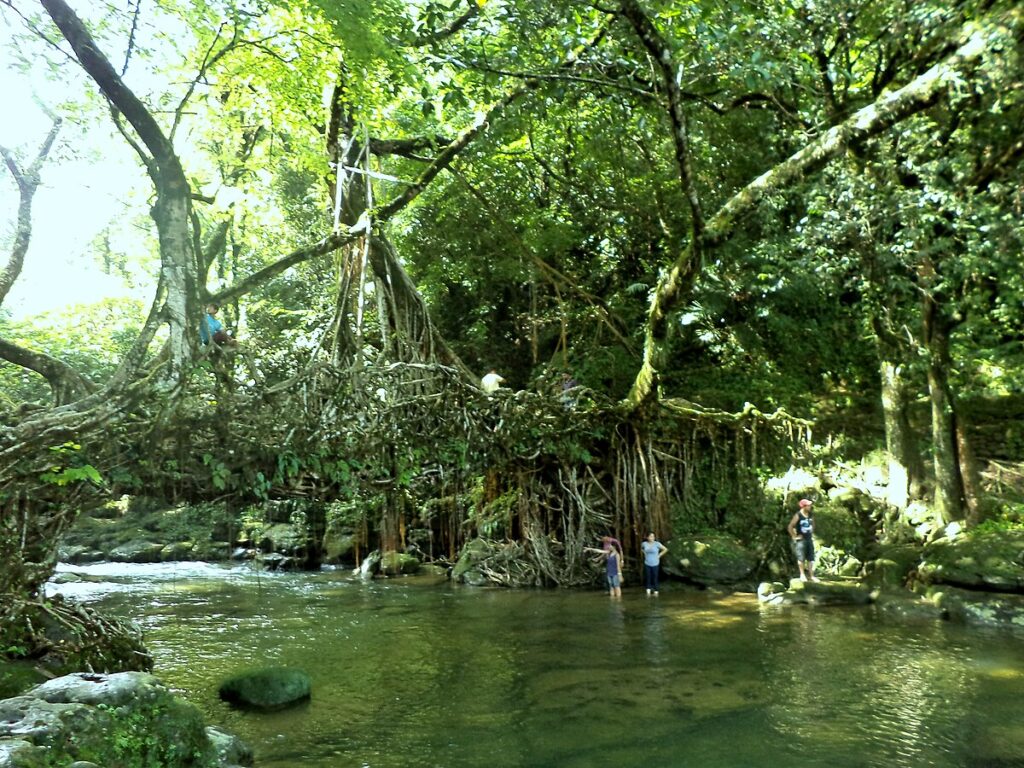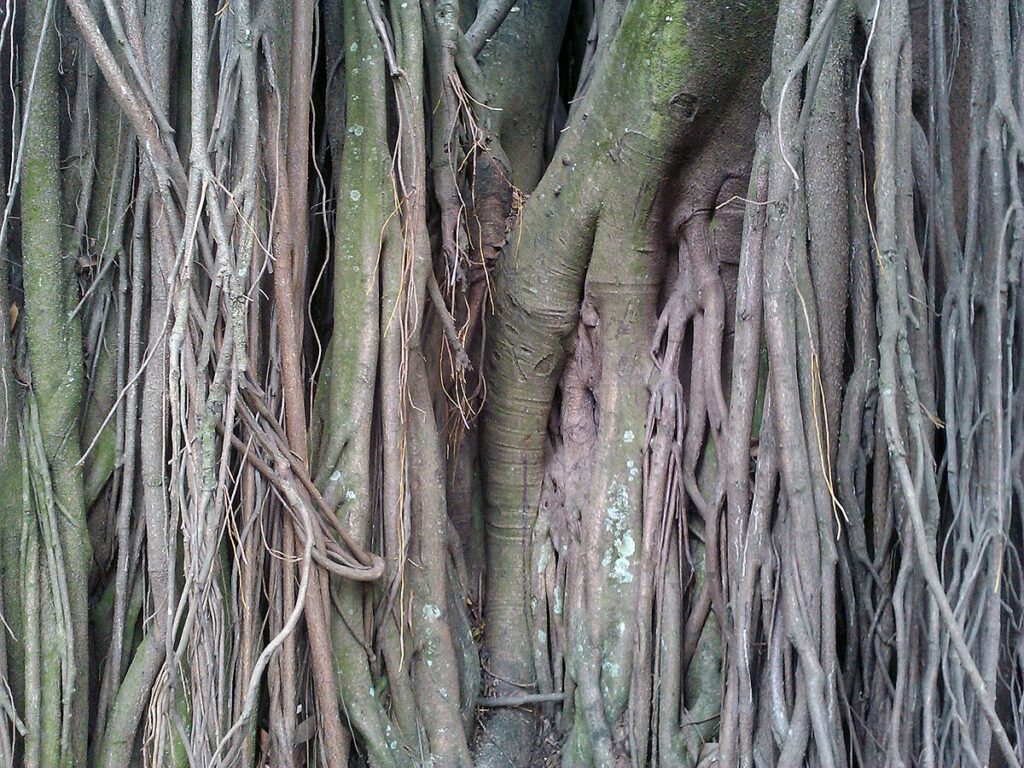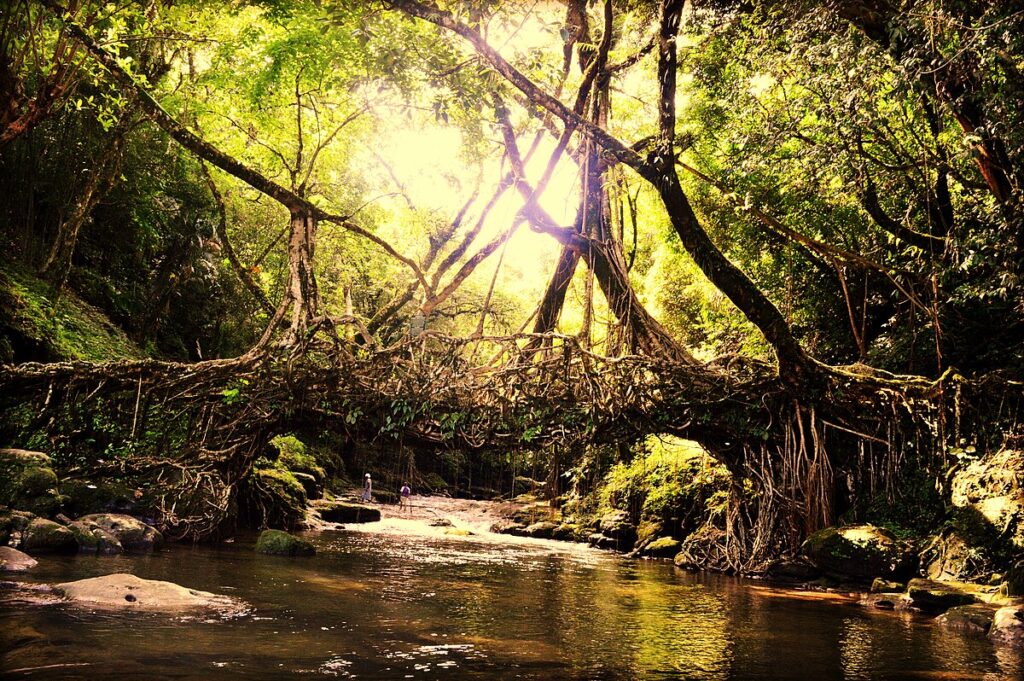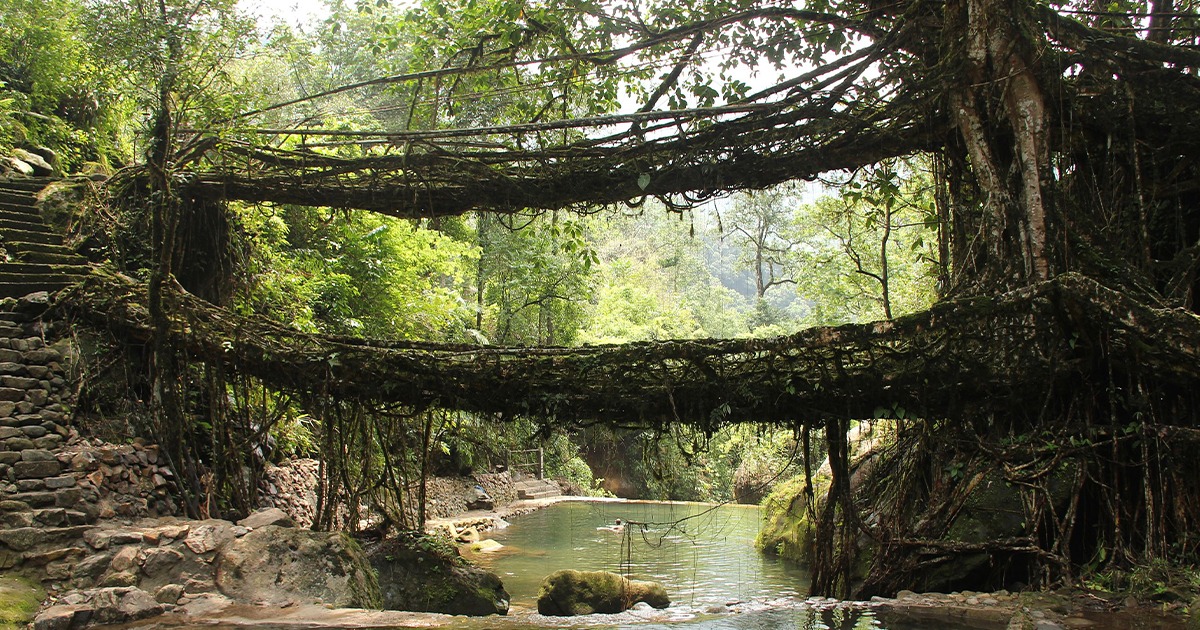In the misty hills of Meghalaya, bridges are not only built, they are grown. Villagers in the Khasi and Jaintia hills train the aerial roots of the rubber fig into pathways that cross gorges and fast rivers. These living structures carry people, baskets, and stories. They need time and patience instead of cement. They do not rust. They do not burn. As the trees mature, the bridges deepen, thicken, and gain strength. It is engineering with sap rather than steel, learned by watching how roots search for soil and water.
The first sight can feel unreal. A span of interlaced roots, glossy after rain, pulls tight from bank to bank. Handrails twist upward like braided rope. Vines thread through gaps. Below, a river slides past boulders as big as huts. The bridge moves a little underfoot. It feels alive because it is. That sense of life, combined with practical toughness, explains why these crossings have endured in one of the wettest places on earth.
What a living root bridge is
A living root bridge begins with a rubber fig tree, Ficus elastica, growing close to a stream. The tree sends out aerial roots that hang like cords. Builders guide those roots across the water with patience and simple tools. The roots are pulled, tied, and sometimes threaded through a kind of natural pipe. As they thicken, they grip rock and soil and bind with one another. Over years the span becomes a footpath. In time it becomes a lane that can carry dozens of people at once.
Each bridge is a one-off, grown to fit a particular bend or slope. Some are single spans. Others stack into two levels like a double staircase in the air. A few form ladders or platforms. In shape and behaviour they echo modern types. You can read hints of suspension, arch, and truss. Yet they are made without drawings or machines. The design lives in memory and practice, passed down in families and villages.

How people grow them
The core method is straightforward. Builders plant or select rubber fig trees on both sides of a stream. Young roots are coaxed across using guides. Hollowed trunks of areca palm or lengths of bamboo act like conduits. Roots are threaded through these channels so they remain straight and protected while they reach the far side. Once a root touches soil, it thickens and anchors. More roots follow and are woven into the span.
Maintenance is part of the craft. New roots are trained in, weak roots are pruned, and loose fibres are tied back into place. Storms can tear at edges, so people walk the bridges after heavy rain and repair what needs attention. The work is quiet, small in scale, and continuous. Instead of heavy labour for a few months, the bridge asks for light work most years.
Time as a building material
These crossings are not instant. A young bridge might take a decade before it feels safe. A mature bridge can carry crowds. Age is not a threat here. It is an asset. As roots grow they thicken and fuse, a process called inosculation. The wood becomes a lattice that behaves like a bundle of cables locked together. The longer the bridge lives, the more paths the forces can take. Where a plank bridge grows tired under load, a root bridge often gains options.
Time also makes the path more comfortable. Early spans feel springy and narrow. With growth, the surface smooths and the handrails settle. Moss fills gaps. Local people add stone pavers and gravel to flatten the tread. The result is a walkway that looks rustic but feels secure.
Why they work in this landscape
Meghalaya’s southern escarpment catches monsoon clouds. Rain comes in sheets. Rivers rise fast and drop just as quickly. Metal bridges corrode. Timber rots. Concrete can wash away where foundations are poor. A living root bridge rides out this chaos. Roots grip rock. The span flexes slightly when floods push debris against it. If a section fails, fresh growth can be trained to replace it. The system adapts because the material adapts.
The trees help beyond the span itself. Their canopies shade the stream, cooling water and slowing evaporation. Root mats stabilise banks and limit landslides on steep paths. Birds nest in the crown. Bees find flowers in the dry months. The bridge is not just a crossing. It is a piece of woodland that happens to carry people.

Knowledge held in common
The Khasi and Jaintia communities treat bridge making as shared practice. No single person “owns” the method. Villages agree on maintenance. Families teach children how to spot a healthy root, when to guide a shoot, and how to tie a splice that does not choke growth. Work parties clear paths and repair handrails at the start of the wet season. When visitors arrive, a local guide often keeps walking time steady and discourages crowding on delicate spans.
That shared care shows in the way bridges age. Some crossings have been tended for many generations. Others fell from use when a path changed and the village moved. You can still find ghost bridges in the forest such as twisted masses where rails outgrew the track. They remind people that living structures need living attention.
Forms, sizes, and famous examples
Many visitors know the double-decker near Nongriat. Two tiers cross a boulder-choked stream under a curtain of rainforest. The lower span came first, then the upper. In other valleys you can find single spans that stretch far across a torrent, and compact bridges tucked into narrow ravines. A handful of bridges run to lengths that surprise even seasoned walkers. In the Pynursla region, some spans approach the width of a small road when measured at the crown of the root mass.
Each site asks for a different approach. On a steep slope, builders bias the weave to one side so the bridge sits level when loaded. Where the river breathes wider in flood, they plant flexible rails that can yield and recover. Over rock shelves, they anchor roots into natural cracks. The result is a collection of structures that look related yet never repeat exactly.
Material science in the forest
Study a bridge with an engineer’s eyes and the tricks become clear. Aerial roots behave like cables in tension. Where they cross and fuse, they act like joints. The mass of roots at the banks works like an abutment. Add stones on top and you get weight that improves stability and comfort. Because the system can grow and change, it handles stress differently from fixed materials. If one path is overloaded, growth can reinforce it over time. The bridge tends toward redundancy, which is a fine quality in a place that sees cloudburst rain.
Microscopy shows why the material performs well. Root tissues lay down new wood each season. Fibres align along the direction of stress. When two roots press together, their cambium layers can merge. That creates a natural splice which slowly strengthens with each growth ring. It is not magic. It is biology working with gravity and load.

Culture, story, and everyday use
For local people these crossings are part of the day’s work. They link farms and schools. They shorten a journey to market. They provide safe routes in a land of slick stone and sudden streams. Children learn to cross them early. Elders set the pace and choose when to rest. The bridges support rituals too. Festivals and family events often require visits to relatives across the valley. A sound bridge makes those visits possible when the rain is at its heaviest.
Stories cluster around particular spans. Some tales recall first builders who planted trees as newly married couples and saw the bridge ready for their grandchildren. Others speak of repairs after a violent flood. These accounts are practical and proud. They record who cares for a place and how a community solves a shared problem.
Recognition and protection
There is growing interest in formal recognition. Cultural bodies and conservation groups have proposed the living root bridge landscapes for heritage status. The argument is simple. These crossings combine indigenous knowledge, ecology, and engineering in a way that few other traditions match. Workshops, exhibitions, and field studies now collect data on locations, conditions, and needs. The aim is to protect the practice as well as the bridges.
Local government programmes have also begun to support documentation and careful tourism. Some funds go to path repair and signage. Some support training for guides and maintenance teams. The hope is to keep bridges open for villagers first, while giving visitors a way to see them without harm.

Seeing the bridges well
Footwork matters here. Trails are steep. Stone steps can run for thousands in a single journey. In wet weather, the rock sweats and grips unevenly. Walk with patience. Keep the group small on the span. Let people pass who carry loads. Do not poke fresh roots or pry at ties. If you stop for a picture, step to one side and keep an eye on your footing. A good walk feels better when it ends without slips.
Guides often share small details that deepen the visit. You may learn how to spot a healthy cambium. You may see a young root threaded through a palm trunk, the channel acting like a mould. You might notice a rail that looks green in one section and brown in another. That is age talking. New growth darkens as it thickens. It is the bridge telling you it is still at work.
Lessons for modern design
These structures challenge habits. Modern building splits roles into design, construction, and maintenance. Here, those roles blur. The plan is a memory. The construction lasts years. The maintenance is growth. The bridge is a process more than a product. Designers who care about climate and material cycles can learn from that. Building with time and care rather than scale and speed will not suit every need, yet it offers a clear alternative in the right places.
There is also a lesson in redundancy and repair. A living span expects to change. It builds safety by adding more paths for force to travel. It assumes someone will check it after a storm. It rewards steady attention. Those are healthy assumptions in any system, whether a bridge, a farm, or a city’s drains.
The future of a living craft
The bridges are resilient, yet they are not invulnerable. Roads pull travel away from footpaths. Some villages find fewer young people available for maintenance. Heavy tourism can crowd spans and wear approaches. Thoughtful planning can answer these pressures. Clear routes spread footfall. Capacity limits protect delicate sites. Community funds pay for steps and handrails without changing the character of the place.
Schools that teach the craft keep it alive. Field days where children help thread a young root plant a seed of pride. Short films and exhibitions share the method with neighbours who might revive an old path or start a new one. The idea travels, but the heart of it remains local: a village, a tree, a stream, and time.
What to remember
Stand on a root bridge and you feel a different clock. Your foot meets wood that began as a hair-thin thread. Someone guided that thread years ago. Someone else will tend it next season. In a world that prizes speed, it is good to cross a river on patience. The span below you shows what happens when a community works with a tree rather than against it. The crossing is quiet, strong, and kind to the valley that holds it.
